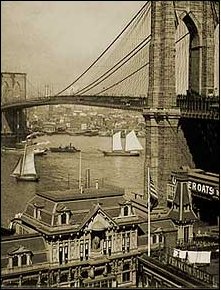|
Turn-of-the-century New York was a kaleidoscope of elements--opulence and poverty, excitement and despair, beauty and ugliness--all jostling each other, making new patterns with every shift.
During the years of this book, 1892 to 1908, New York emerged as a burgeoning metropolis, the nation's commercial and cultural center. Already, the two iconic and monumental structures were in place.
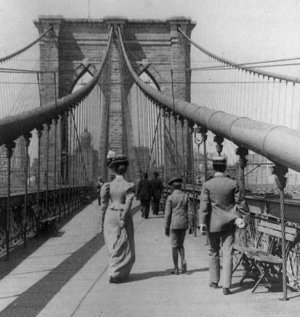
|
|
Promenade, Brooklyn Bridge.
|

High above the East River, a roadway had been flung over the tops of masts, suspended on wire threads between two lordly towers with double Gothic arches, seven times taller than the four-story skyline. The colossus of the Brooklyn Bridge spoke of fourteen years of courage and daring, genius and human effort on a grand scale. Its effect was inspirational, declaring that sustained effort will bring about brilliant accomplishment.
|
|
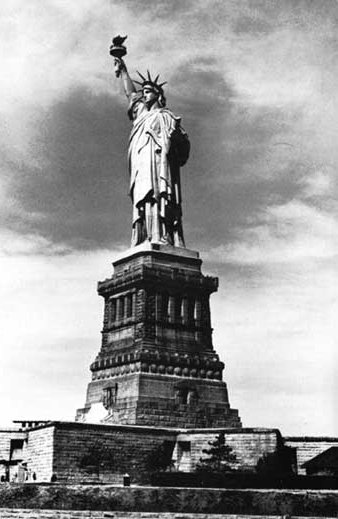
|
|
Statue of Liberty, "."Liberty Leading the People
|

Up, out of murky water, the Statue of Liberty proclaimed with upraised arm thirty stories in the air the principles of friendship and welcome and hope, the possibilities of contribution and achievement. Liberty Enlightening the World was commemorated by Emma Lazarus, daughter of immigrants, in her sonnet, "The New Colossus."
Not like the brazen giant of Greek fame,
With conquering limbs astride from land to land;
Here at our sea-washed, sunset gates shall stand
A mighty woman with a torch, whose flame
Is the imprisoned lightning, and her name
Mother of Exiles. From her beacon-hand
Glows world-wide welcome; her mild eyes command
The air-bridged harbor that twin cities frame.
"Keep, ancient lands, your storied pomp!" cries she
With silent lips. "Give me your tired, your poor,
Your huddled masses yearning to breathe free,
The wretched refuse of your teeming shore.
Send these, the homeless, tempest-tost to me,
I lift my lamp beside the golden door."
Both structures, as well as the poem, play a metaphoric role in the narrative of Clara and Mr. Tiffany
Change was happening, and Clara was there to witness it: One hundred thousand people, Clara among them, turned out in pouring rain on New Year's Eve in 1897 to celebrate the consolidation of the five boroughs into one mega-city of over three million. Three years later, she saw electricity borrow light from heaven to illuminate City Hall with thousands of lights at the midnight turn of the century. Steam-powered elevated trains rumbled and screeched on girders above the city streets even after electric trains ran underground. The city was growing northward as well as upward, and in 1904 knowing city planners laid the subway through yet undeveloped areas to 145th Street, and the 800 acres of Central Park, the first landscaped public park in the nation, provided the healing power of nature amid the clang and crush of the city.
|
|
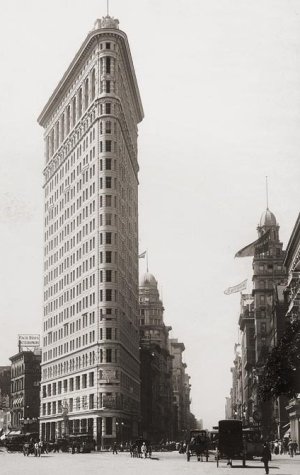
|
|
The Fuller-Flatiron Building, corner of Broadway and Fifth Avenue at 23rd St., New York.
|

In 1903 Clara and her friends from the boardinghouse saw the construction of the twenty-two story Fuller-Flatiron Building on the triangle of land where Broadway and Fifth Avenue cross each other at 23rd Street. The New York Times Building rose two stories taller at what was first called Longacre Square, and a 700-pound ball lit with 25-watt electric bulbs dropped from its spire for the first time in 1904. From that point on, New Yorkers were enthralled by height, and a new word was born: skyscraper.
|
|
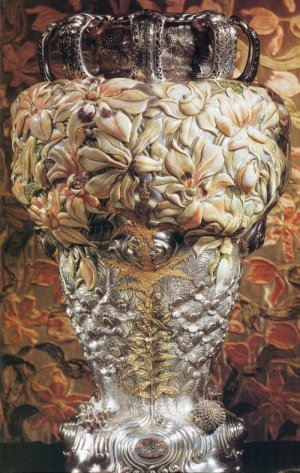
|
|
Magnolia vase, created by Tiffany Glass and Decoration Company for the World's Columbia Exposition, 1893. Silver, gold, enamel, and opal.
|

The Gilded Age
Coined by Mark Twain in his novel of the same name, The Gilded Age was the work of rich industrialists and financiers such as Cornelius Vanderbilt, John D. Rockefeller, Andrew Mellon, Andrew Carnegie, and J.P. Morgan, robber barons critics called them, who nevertheless left their mark on the city. These and others less well-known were the customers of both Charles Tiffany who founded the luxury goods store of Tiffany & Company, and his son, Louis Comfort Tiffany, and, by extension, Clara Driscoll. The nation was reinventing itself, becoming a society that measured personal worth by money and extravagant possessions. In effect, Tiffany Studios might have been limited to church window commissions were it not for the upper class hunger to exhibit their wealth by decorating their mansions in the city and beyond.
|
|
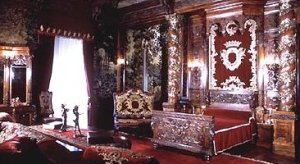
|
|
Bedroom of Frederick Vanderbilt, Vanderbilt Mansion, Hyde Park, NY. Interior design by Georges Glaenzer and George Waldo, a friend of Clara Driscoll and a character in the novel. National Park Service photo.
|

Not only in the opulent two-and-a-half miles of Fifth Avenue, the place to make it and flaunt it, but in the realm of public philanthropy, wealth became the subject of legend. Andrew Carnegie's "Gospel of Wealth" spread, and private donors funded thousands of colleges, hospitals, museums, academies, opera houses, libraries, symphony orchestras, among them the Metropolitan Opera and the Metropolitan Museum of Art, both of which Clara loved.
|
|
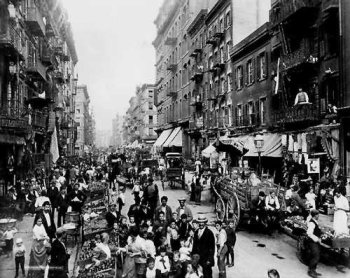
|
|
A Lower East Side street, c 1899.
|

However, progress, plenty, and poverty became the enigma of the city.
The Lower East Side
|
|
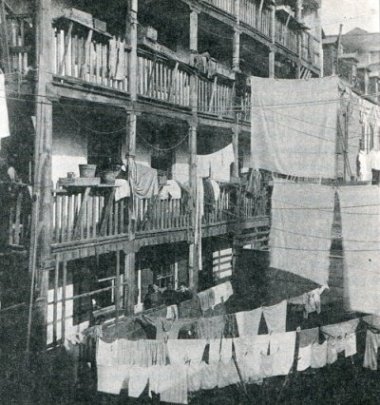
|
|
An Old Rear-Tenement, Roosevelt Street, once under the Brooklyn Bridge, displaced by Alfred E. Smith Housing Project. Photo: Jacob Riis, in How the Other Half Lives, 1890.
|

A wilderness of tenements jammed the space between Bowery Street to the Brooklyn Bridge, housing numbers of people too vast to grasp. A five-story tenement on Orchard Street, preserved as the Lower East Side Tenement National Historic Site, housed 7,000 people of more than twenty nationalities, with two toilets per floor. There were more Italians in New York than in Naples, more Irish than in Dublin.
The hopeful came from some twenty countries, each of them wondering, How much will I have to let go of who I have been?
|
|
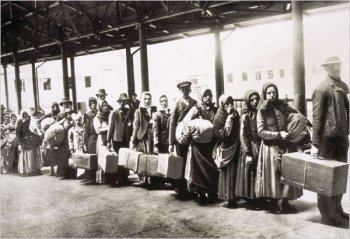
|
|
Immigrants Arriving at Ellis Island Immigration Station.
|

During 1892, the year the Ellis Island Immigration Station opened, and the year book opens, 450,000 immigrants took their first steps on American soil.
|
|
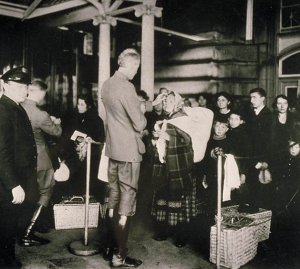
|
|
Doctor Examining Immigrants at Ellis Island, 1904. National Park Service, Statue of Liberty National Monument, public domain.
|

In the peak year of immigration, 1907, more than a million immigrants were "processed."
Included in a brusque physical examination was a lifting of eyelids to check for disease. Those who didn't pass had to return to their home port.
|
|
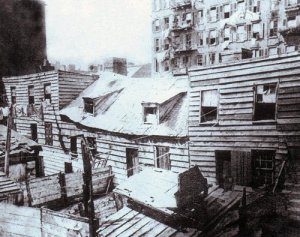
|
|
Squalid housing was referred to as "Dens of Death"
|

One Danish immigrant, Jacob Riis, having suffered joblessness, hunger, homelessness, and thoughts of suicide, was finally able to get a position as police reporter in the Lower East Side. In photographs, illustrations, statistics, and shocking text, he documented squalid living conditions, filth, disease, overcrowding, and exploitation, and published How the Other Half Lives: Studies among the Tenements of New York in 1890. A few of his image titles are sufficient to unleash the imagination: "Upstairs in Blindman's Alley," "Gotham Court," "Bandits' Roost," "Sewing and Starving in an Elizabeth Street Attic," "Didn't Live Nowhere."
Clara's story touches on this milieu too.
|
|
The Settlement House Movement
One mitigating factor was the settlement house movement, begun when Jane Addams set up Hull House in one of Chicago's most impoverished immigrant wards. Educated men and women took up residence in the settlement houses to live and work among the poor--providing assistance to find jobs, housing, medical services, and English language classes. Differing from condescending Victorian charity institutions, they stressed the interdependence of all citizens, strong advocacy of labor organizations, and politically progressive reform.
"You might say I live in the teeming cradle of the promise of this country," says Clara's friend Edwin Waldo, assistant to the director of University Settlement House. "The immigrants of the Fourth Ward have troubles, almost insurmountable troubles, but they have dreams, too, and ambitions and loves and sorrows. Each person may have left parents and grandparents behind, sisters behind. They gave up their languages and their countries, but each one brings with him a story."
|
|

|
|
Southwest corner of Irving Place and 16th St., 1909. Clara's boardinghouse is in this block, south of Gramercy Park. New York Historical Society, permission pending.
|

Boardinghouses
Midway between the mansions of Fifth Avenue and the tenements of the Lower East Side were thousands of boardinghouses which served the majority of middle-class New Yorkers. Into this time and place rode Clara Driscoll, a woman awheel.
|
|


